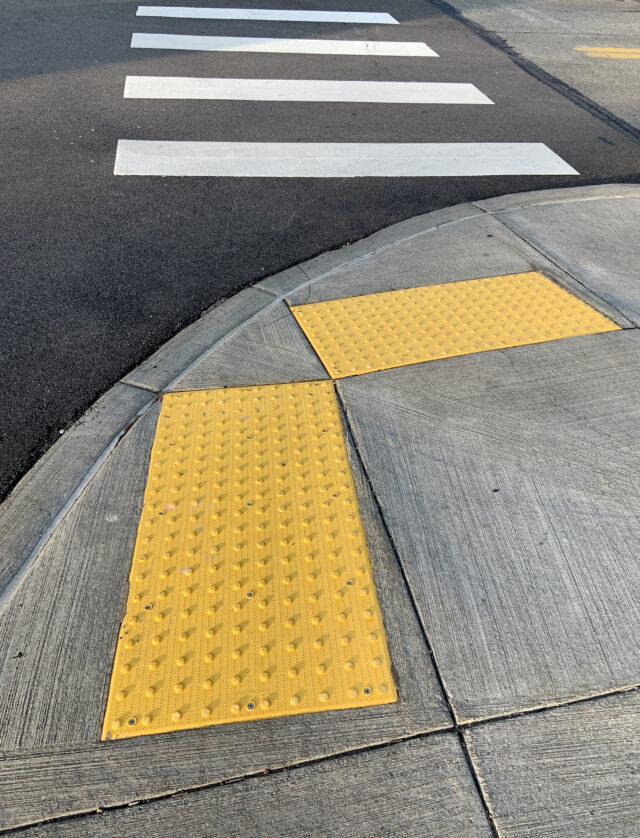Key Considerations for Local Governments Seeking Compliance With the Americans with Disabilities Act

The Centers for Disease Control (CDC) estimates that one-in-four adults in the United States is living with a disability, and that number may still rise as our largest generation, the Baby Boomers, continues to age. Though the Americans with Disabilities Act (ADA) is more than 30 years old, continuing to inventory and address the accessibility of the built environment is an ongoing effort for many local governments. Fortunately, there are new tools to make collecting, evaluating, and prioritizing this inventory data easier.
What Does the ADA Require?
The ADA was enacted more than 30 years ago and updated in 2010. This landmark legislation provides comprehensive civil rights protections to persons with disabilities in the areas of employment, state and local government services, and access to public accommodations, transportation, and telecommunications. Title II of the ADA applies to “public entities” (i.e., state and local governments), specifically the programs, services, and activities they deliver. Title II, Article 8 requires that each public agency develop a transition plan that ensures accessible facilities are provided in the public right-of-way.
State agencies and other public funding sources have heightened local awareness of ADA requirements, linking the release of transportation funds to the completion of transition plans. Transition plans must, at a minimum, include:
- A list of the physical barriers and their location in a public entity’s facilities that limit the accessibility of its programs, activities, or services to individuals with disabilities
- A detailed outline of the methods to be utilized to remove these barriers and make facilities accessible
- The schedule for taking the necessary steps to achieve compliance with Title II
- Public complaint/grievance procedures
- The name and position of the ADA coordinator and/or official responsible for the plan’s implementation
Transition plans provide a method for a public entity to schedule and implement ADA required improvements to existing streets and sidewalks. Before a transition plan can be developed, an inventory of curb ramps and sidewalks must be developed. Depending on the amount of pedestrian infrastructure in your community, this can be a labor-intensive effort.
Evaluating Pedestrian Accessibility
The United States Access Board established proposed guidelines to assist in the evaluation of accessibility of public facilities, called “Proposed Accessibility Guidelines for Pedestrian Facilities in the Public Right-of-Way.” Not yet formally adopted by the U.S. Justice Department, the Public Rights-of-Way Accessibility Guidelines (PROWAG) are accepted as policy and provide the framework for evaluating pedestrian facilities in the preparation of transition plans.
PROWAG provides design guidance for a wide variety of facilities in the public right-of-way, including curb ramps, sidewalks and pedestrian access routes, traffic signals, and signage. Many of the guidelines are oriented to people who use a wheelchair or have limited vision, though the guidance is intended to eliminate all access barriers.
ADA transition plans start with self-evaluation of your pedestrian facilities. Self-evaluation involves observing and inspecting key elements of the pedestrian system and scoring facilities for compliance with the standards and PROWAG. For example, is there a functional curb ramp? Is a detectable warning strip present? Is there a defined crossing and is a pedestrian-activated signal present? This is just a sample of elements included in a self-evaluation. The inventory is completed by mapping and walking pedestrian routes and logging the evaluation into software.
LaBella has been engaged with transportation and planning agencies to develop a program to assist local communities in completing their ADA transition plans, starting with developing standard criteria for facilities based on the ADA standards and PROWAG guidelines. Using this framework, data collection personnel were trained in the assessment process and the use of mobile technology for data collection.
How Can Technology Assist in This Effort?
Collecting, inputting, and analyzing this data can be accomplished simply and easily with the use of geographic information systems (GIS), which is a term that refers to any computer system that combines data with mapping (geography).
For our work, we used GIS platform Esri, and a variety of their software solutions. A few components of our technology application were:
- Data Preparation and Sharing: The success of fieldwork depends on effective planning. We used the ArcGIS Online platform for web maps. This allowed the team to plan efficient team assignments and work routes for the fieldwork. As data was collected, the map was updated in real time, allowing field teams and managers to see progress. Web maps are already commonly used by municipalities; although this technology’s capabilities were highlighted during COVID with the creation of tracking dashboards, it has long been used for other applications like campsite reservations.
- Field Data Collection: We used Esri’s ArcGIS Field Maps for field data. The app allows users to capture locations of pedestrian infrastructure, including photos, and reference other GIS data (like roads, parcels, or zoning) from their mobile devices. We also used a form-building application, ArcGIS Survey 123, to create intelligent and intuitive digital survey forms. Both applications allow experts not present in the field to review data in real time.
- Data Analysis and Recommendations: Once the data was collected, additional layers of GIS data helped us analyze and prioritize locations for corrective action. For example, GIS data allowed us to look at key zoning areas, adjacency to parks, schools, medical facilities, and historical landmarks, while also considering risk factors like intersections with high rates of vehicular accidents. Combining these factors gave municipal leaders a clear understanding of how to phase improvements.
Transition plans are an important part of compliance with ADA. A consultant with an understanding of the regulations in play and GIS expertise can provide the foundational data you need to develop an effective plan. Proactively addressing mobility barriers improves your community’s eligibility for funding and ensures public services are accessible to your entire community.
*This article was featured in American City & County, a publication that provides elected and appointed public officials with news, government trends, policy alternatives, and operational solutions.

About the Author
Chris Round, AICPPlanning Discipline Leader
Chris has 30 years of experience providing land use planning and environmental services to local governments, institutions, and private clients. He is experienced in the development of municipal plans and land use regulations, public participation, and outreach efforts, as well as securing grant funds for public and private entities. As Planning Discipline Leader at LaBella Associates, Chris is responsible for the overall operations of the service line and the management of complex interdisciplinary projects.